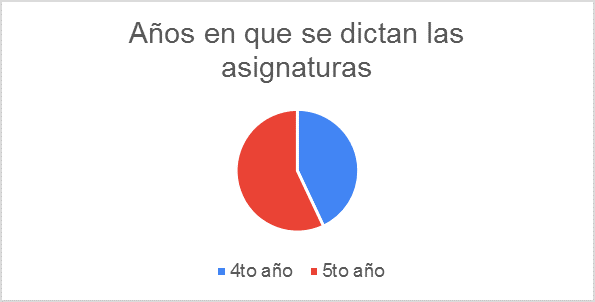

Translated from the original in Spanish
Identification of digital gaps in pandemic: two experiences of higher grades in the Informatics discipline
Identificación de brechas digitales en pandemia: dos experiencias de grados superiores en la disciplina Informática
Identificação de lacunas digitais em pandemias: duas experiências de nível superior na disciplina de informática
Sonia Itati Mariño, Viviana R. Bercheñi
Universidad Nacional del Nordeste. Argentina. ORCID: http://orcid.org/0000-0003-3529-7003, http://orcid.org/0000-0003-4205-8609. Correo electrónico: simarinio@yahoo.com, viviber@hotmail.com
Received: September12th, 2020
Approved: October 22nd, 2020
ABSTRACT
The global health crisis caused by COVID-19 forced the anticipated shift from the "face-to-face" to the "virtual" paradigm. The article proposed to determine different digital gaps in the educational system of the National University of the Northeast. In order to validate the proposal, we chose two higher-level subjects from the Bachelor's Degree in Information Systems. An online survey was designed to quantitatively infer and characterize individuals in relation to certain aspects that affect a typology of digital divide: connectivity, availability of relevant communication and computer equipment, and knowledge of synchronous and asynchronous tools in a learning environment or virtual classroom, the data were processed and descriptive statistical measures applied. The information produced determined the non-existence of evidence regarding the use gap, however, the presence of the access gap and skills gap was observed in 29% of the total number of students interviewed. The proposal was aimed at proposing to implement in other educational areas (for example, in the teaching sector, administrative and teacher personnel), the design of strengthening projects in information and communication technologies in order to ensure having trained human capital in the face of possible emerging.
Keywords: digital divide; development; higher education; equity.
RESUMEN
La crisis sanitaria mundial originada por el COVID-19 forzó el cambio anticipado desde el paradigma "presencial" al "virtual". El artículo propuso determinar diferentes brechas digitales en el sistema educativo de la Universidad Nacional del Nordeste. Para validar la propuesta se optó por dos asignaturas de grado superior de la carrera Licenciatura en Sistemas de Información. Se diseñó un relevamiento en-línea para inferir cuantitativamente y caracterizar a los individuos en relación con ciertos aspectos que inciden en una tipología de brecha digital: la conectividad, disponibilidad de equipos de comunicación e informáticos pertinentes, y conocimientos de herramientas sincrónicas y asincrónicas en un entorno de aprendizaje o aula virtual; los datos se procesaron y aplicaron medidas estadísticas descriptivas. La información producida determinó la inexistencia de evidencias en torno a la brecha de uso; sin embargo, se observó la presencia en un 29 % del total de alumnos entrevistados de la existencia de la brecha de acceso y brecha competencial. La propuesta se orientó a implementar en otros ámbitos educativos (por ejemplo, en el sector docente, personal administrativo y de maestranza), el diseño de proyectos de fortalecimiento en tecnologías de información y comunicaciones, de modo que asegurara contar con capital humano capacitado ante posibles emergentes.
Palabras clave: brecha digital; desarrollo; educación superior; equidad.
RESUMO
A crise de saúde global causada pela COVID-19 forçou a mudança antecipada do paradigma "cara a cara" para o paradigma "virtual". O artigo propôs a identificação de diferentes lacunas digitais no sistema educativo da Universidade Nacional do Nordeste. A fim de validar a proposta, foram escolhidos dois temas do curso de licenciatura em Sistemas de Informação. Um inquérito em linha foi concebido para inferir quantitativamente e caracterizar indivíduos em relação a certos aspectos que afetam uma tipologia de lacuna digital: conectividade, disponibilidade de equipamento informático e de comunicação relevante, e conhecimento de ferramentas síncronas e assíncronas num ambiente de aprendizagem ou numa sala de aula virtual; os dados foram processados e foram aplicadas medidas estatísticas descritivas. A informação produzida determinou a inexistência de provas relativamente à lacuna de utilização; contudo, a presença da lacuna de acesso e competência foi observada em 29% do número total de estudantes entrevistados. A proposta foi orientada para implementar noutros ambientes educacionais (por exemplo, no sector do ensino, pessoal administrativo e de mestrado), a concepção de projetos para reforçar as tecnologias de informação e comunicação, de modo a assegurar que o capital humano formado esteja disponível para possíveis questões emergentes.
Palavras-chave: Lacuna digital; Desenvolvimento; Ensino superior; Equidade.
INTRODUCTION
The digital transformation in Argentina has begun to notice a great impact as of mid-March 2020. On this date the health emergency and preventive and mandatory social isolation are declared.
In this context of national emergency, most of the activities identified as non-essential began to be developed virtually, from homes, revealing inequalities based on belonging to different social strata, geographic location, technological inclusion, qualification, among others others, either in developed or underdeveloped countries.
The compulsory isolation has deepened the dependence of individuals (adults and young people) towards technology and shows material, intellectual and psychological deficiencies that make this paradigm shift from the "face-to-face" to the "virtual" more difficult , revealing the existence of gaps in terms of access to technology of segments of people that denote difficulties in their work and school performance.
From a social and academic perspective, the right to learning of students should be prioritized, understood as an essential human right that guarantees them social mobility in many cases.
Garcia, Correl , Abella & Large ( 2020) poses that at the university urgent transformation of the actual classes to a format online was carried out in a way that can be described as broadly acceptable ; Although the measures taken have been adjusted to the urgency and not to a planning thought a priori to teach a subject with a completely online methodology .
In the academy, countless reflections and experiences have been designed and disseminated. Some of them are related to the rethinking of the essential functions of the Argentine university, in a context of health emergency, extending the role of professors and workers who are linked to academic activities, in terms of the reformulation of the design, organization and implementation in practice of new forms and procedures to practice teaching, research and extension in a pandemic situation. In this direction, the United Nations Organization for Education, Science and Culture and the International Institute for Higher Education in Latin America and the Caribbean, have issued a set of guiding principles to plan the exit of the crisis COVID-19 in the Higher education (Ordorika, 2020) .
In the aforementioned context, Gavilán (2020) outlines two axes of inquiry. One of them related to Technology Information and the Communications (ICT) and Disruptive virtuality arises because "isolation and other forms of academic political cultural intervention, and produced by the effects of COVID-19" ; In this context, he places the massive nature of the different activities ,It must be teaching , professional, training, consumer, among others, through the web.
In López & Rodríguez (2020) there are established three lines of action: How can this situation influence on the academic progress of students, what actions can the institutions of higher education and teachers take and which proposed actions related to end of the pandemic may be raised. These questions certainly do not involve generalized answers, because the realities in health crisis scenarios, neither will be. It is estimated that the common element that must be present in this sense should be the solidarity and commitment of the community to transcend the difficulties or weaknesses identified.
The digital divide arises in the context of a pandemic, due to the disruption of access to technology, inappropriate training for the use of tools, inadequate connectivity, insufficient devices for the development of academic activities in teachers and students, among others. In turn, as the change was abrupt, there was not enough time to make the necessary adjustments to adapt to the new reality. Neither the market supplier of inputs, and computers, could supply this increased demand. In this sense, the pandemic put technology and government models into proof. Herrera & Navia, 2020).
García Peñalvo et al. (2020) indicate three observable gaps in access to technology among young students:
From this perspective, and in coincidence with Archer & De Gracia (2020), the pandemic situation has begun to accelerate the use and adaptation of online education, which has highlighted a well-known problem, such as inequality in the access to technology and its effective application. Inequalities that will imply that governments define inclusion strategies, as far as possible, to prevent school dropouts from being permanent or significant.
Therefore, the objective of the article is to identify the existence of digital gaps, in the students of two subjects of the upper years of the degree of Information Systems (LSI) career, in a specific context such as the public university in the northeast of Argentina , in the face of a health crisis scenario. To do this, a survey was designed and applied in the subjects Applied Economics and Models and Simulation.
MATERIALS AND METHODS
The proposed research design is the case study. It was an investigation of a descriptive, exploratory and interpretive nature. It consisted of the following phases:
Phase 1. Selection of study objects
The subjects Applied Economics and Models and Simulation were selected as the object of study, whose characteristics and approach strategies were as follows.
The Applied Economics subject is quarterly and is dictated in the fourth year of the LSI career. Its overall objective is to make the link between the technical knowledge that students acquire the specific subjects of the career, with the strategic objectives of organizations and with their environment. By passing the course, students are able to integrate information technology with the mission and vision of for-profit organizations.
During the period 2020, due to health crisis caused by the COVID-19, the planned activities were carried out through synchronous and asynchronous operations using the latter channels on Youtube authorised for this purpose. The virtual classroom of the University (based on the Moodle platform) was also used, so that the students had the necessary bibliography, the subject material and the digital presentations with explanatory audios of topics related to the design and development of enterprises. The synchronous interventions were developed through Google Meet and Zoom.
The subject Models and Simulation is quarterly and is taught in the fifth year of the LSI degree program. In its approach, the search and solution of scientific and professional problems is emphasized , applying specific techniques, orienting its general objective to provide a solid training in the management of concepts and methods for the simulation of systems through the digital processing of mathematical models. These contents are contemplated according to the curricular guidelines expressed in Ministerial Resolution No. 786/09 (Ministry of Education of the Argentine Republic, 2009).
In the subject, theoretical- practical and laboratory classes are taught. To promote students must complete various evaluative bodies and preparation and presentation of an Integrated Practical Work (TFI), analyzed in this experience.
In the period 2020, due to health crisis caused by the COVID-19, the planned activities were carried out through synchronous and asynchronous interventions integrated into an EVA - based on Classroom. In particular, the synchronous interventions were developed through Google Meet and Zoom.
Phase 2. Identification of technological gaps
A preliminary quantitative characterization was proposed trying to infer the existence and nature of the technological gaps in students of two subjects of the upper cycle of the LSI career.
A survey designed for the purposes of this inquiry was applied with closed and open questions; It was used a form of Google for capturing data. The sample was not intentional; They were invited to the students who completed both subjects previously characterized.
The instrument consisted of the following closed questions:
In addition, the following open questions were included:
Phase 3. Analysis of the information to determine typologies of digital divides
RESULTS
The totalizing expansion of ICT determined, and in this different studies from very different scientific fields coincide, the progressive abandonment of the industrial era and the entry into a new historical phase, still under construction, known as a post-industrial society, which has generated inequalities structural aggravated by the effects of the current health crisis.
Among the multiple dimensions of the phenomenon (economic, social, political, cultural, technological, and cognitive or philosophical), it is clear that ICTs profoundly affected work, labor relations, and the social structure (Encabo, 2017).
Purposes of identifying the existence of digital divides it was implemented a survey with a sample of n = 21 , nine students from a total of 35 , of 4 to year and the remaining 12 to 17 students from the course of five to year of the career . The figure 1 shows the percentage of students participating in the survey, which attended the subjects in the period from April to June 2020.
The analysis of the closed questions is summarized below:

Fig. 1- Students belonging to the fourth and fifth year of the L SI who answered the survey

Fig. 2- Number of members per living unit
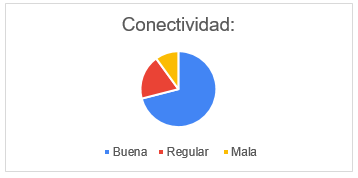
Fig. 3- Opinion around connectivity
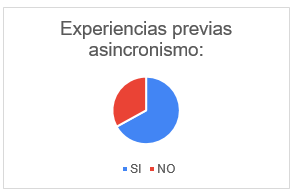
Fig. 4 - Previous educational experiences in relation to the use of asynchronous communication tools
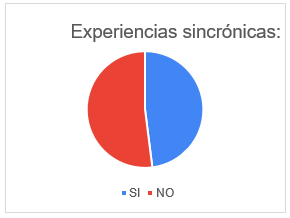
Fig. 5 - Previous educational experiences in relation to the use of synchronous communication tools
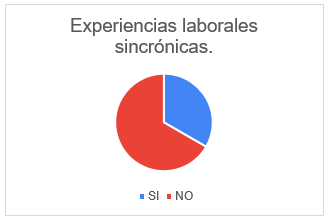
Fig. 6 - Previous work experiences in relation to the use of synchronous communication tools
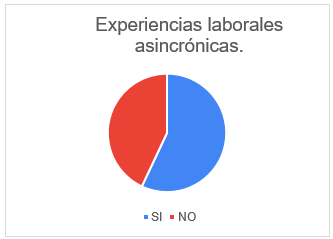
Fig. 7 - Previous work experiences in relation to the use of asynchronous communication tools
Then the strengths, weaknesses and opportunities of the mediated education and ICT inferred from the data processing are mentioned:
This scenario of greater and lesser proximity between the teacher and the student in a situation of preventive, social and compulsory isolation required the clarification, awareness and resolution of issues related to the strengths, weaknesses and opportunities of the educational system.
This emergency context has also evidenced the material and training vulnerabilities of teachers and students that have hindered the disruptive process towards the virtual, generating impacts on the educational quality imparted.
One of the most important challenges of the Public University is to prepare for the new normal that surely requires the university community to transform itself towards digitization, redesigning teaching for scenarios of reduced presence, qualifying all its components, adapting physical classrooms in addition to virtual classrooms, proposing joint strategies with public sectors to provide personal order to students and pose challenges and strategic needs of connectivity in geographic areas that are excluded, among others.
The post- pandemic scenario surely rethinks teaching its true capacity to adapt to technological changes, optimizing the use of information and communication technologies, whether for the design of meetings, classes, exams or virtual encounters between peers or with students. The university classrooms when they reopen will not be the same, nor will their campuses or spaces in the educational field be.
The teachers commitment in this regard was at the level of Sustainable Development Goal 4 (SDG 4) of the UNESCO 2030 Agenda (United Nations Educational, Scientific and Cultural Organization, 2015) which constitutes the synthesis of the ambitions of education, considering it as a human right.
DISCUSSION
The article summarizes the results of the design and implementation of a survey to relieve the existence of digital divides in two subjects of the upper cycle race computer - related discipline, situated at the context of the northeast of Argentina.
As stated previously, the results emerge in an area where students had to face a new paradigm. It is to say in less than a week it was replaced with a model of class with support of mediated resources by ICT, a class model supported with ICT synchronous and asynchronous tools. In this, we agree with Maldonado, Los Angeles, Stratta , Barreda & Zingaretti (2020), who is holding that the health emergency must migrate to a virtual learning environment, which brings with it challenges for all the actors involved in the process; This is where questions arise related to resilience capacity and the development of self-taught capacities in order to achieve meaningful learning. This asseveration was verified in the evidence associated with the high number of students who passed or regularized the subjects.
The health crisis has exposed the shortcomings and limitations, both of the educational system and the student population, in terms of the availability of digital skills and tools simultaneously; aspects that have been mentioned in (García Peñalvo et al., 2020). However, in the present article it emphasizes that previous experiences with studies (figures 4 and 5) and job performance (figures 6 and 7) helped to reduce these difficulties and managed to finish successfully the course and approval of the considered subjects in this study.
In the article, a first approach to the axes proposed by López & Rodríguez (2020) is achieved. In reference to how this situation can affect the academic trajectories of students, it was found that even when the educational paradigm was redefined from a face- to- face mode to a virtual one, in a very short period of time, the learning objectives were achieved in the considered subjects.
Respect to the second axis that is about the actions they can undertake higher education institutions and teachers, it must stress the great effort made by the teaching university sector to guarantee the right of students to receive an inclusive education, equitable and with quality, promoting learning opportunities, as expressed in the UNESCO 2030 Agenda in its fourth sustainable development goal. This effort has been perceived by students, to consider it as the fortress of the mediated education by the ICT, as explicit in previous paragraphs. The actions and evidence achieved in the first semester allowed a closer transition to the new modality of virtual classes in the second semester.
Finally, regarding which proposal of actions relating to the completion of the pandemic can be raised, given the lack of certainty regarding the resumption of face to face classes it will be elaborating protocols, in one principle, to begin classroom activities in university management. In a complementary way, the activities of the student canteens have returned under the modality of withdrawing to consume.
In this sense, and thinking that the economic impact of the pandemic will probably generate a decrease in the demand for higher education services due to the effects of unemployment and loss of income, we reinforce the analysis of Archer & De Gracia (2020) by making visible that an inequality of access to technology is evident due to the type of gap detected; For this reason, the design of inclusive educational policies by institutions and public leaders is essential to support students at risk and to find ways for them to continue their studies. Otherwise, they run the risk of becoming secondary victims of the pandemic and its consequences.
As for the type of the digital gaps existing in the study it is partially consistent with Garcia Peñalvo et al. (2020), two or three gaps listed by the author were identified. In the age group analyzed there were revealed:
From the results obtained in this study , following the typology of García Peñalvo et al. (2020) and what was stated with López & Rodríguez (2020), it should be noted that in the face of the health emergency and to reduce the access gap, from the National University of the Northeast through the different academic units, free navigation was managed by unne.edu.ar sites at the same time there were delivered phone charge cards to help low - income students to use their cell phones to carry out academic activities. In addition, in agreement with these authors and in reference to the need to design immediate inclusive public policies, actions should be implemented aimed at reducing the competence gap and thus have a positive impact on the academic trajectories of students.
Notably the implementation of the survey allowed to validate this instrument of collection of data, with the necessary adaptations allow to collect information on the academic community (students, teachers, staff), actors involved in the educational process. So, so it will constitute relayed information to design a strategy aimed at alleviating digital difficulties related to: connectivity, in relevant informatics means and training in the efficient use of learning tools that support meaningful and administrative processes mediated by the ICT.
The experiences described in the article represent a sample of reality in the educational system and illustrate how subjects are able to adapt to emergencies, such as the health crisis caused by COVID-19. In this sense, and based on the results obtained, some lines of recommendations emerged, among which are mentioned:
BIBLIOGRAPHIC REFERENCES
Archer Svenson, N., & De Gracia, G. (2020). Educación superior y COVID-19 en la República de Panamá. Revista de Educación Superior en América Latina, 0(8). Recuperado a partir de http://rcientificas.uninorte.edu.co/index.php/esal/article/view/13403
Encabo, S. O. (2017). Brecha digital, pobreza y exclusión social. Temas laborales: Revista andaluza de trabajo y bienestar social, (138), 285-313.
García Peñalvo, F. J., Correl, A., Abella García, V., & Grande, M. (2020). La evaluación online en la educación superior en tiempos de la COVID-19. Revista Gestor Online, 21. Recuperado a partir de https://revistas.usal.es/index.php/eks/article/view/eks20202112.
Gavilán, M. (2020). La orientación entre la pandemia y el futuro. Orientación y Sociedad, 20(1). Recuperado a partir de https://revistas.unlp.edu.ar/OrientacionYSociedad/article/view/10238/9016
Herrera Tapia, J., & Navia, M. (2020). Las tecnologías de la información: aliado y soporte para las organizaciones en un mundo en crisis. Revista Ibérica de Sistemas e Tecnologias de Informação, (E29), 11-12.
López Ramírez, M., & Rodríguez, S. A. (2020). Trayectorias escolares en la educación superior ante la pandemia continuar, interrumpir o desistir. En Educación y pandemia: una visión académica (pp. 103-108). México: Universidad Nacional Autónoma de México: Instituto de Investigaciones sobre la Universidad y la Educación.
Maldonado Gómez, G., de los Ángeles Miró, M., Stratta, A. E., Barreda Mendoza, A., & Zingaretti, L. (2020). La educación superior en tiempos de Covid-19: análisis comparativo México-Argentina. Revista de Investigación en Gestión Industrial, Seguridad y Salud en el Trabajo - GISST, 2(2), 35-60. https://doi.org/https://doi.org/10.34893/gisst.v2i2.79
Ministerio de Educación de la República Argentina. (2009). Resolución Ministerial No 786/09. Autor.
Ordorika, I. (2020). Pandemia y educación superior. Revista de la Educación Superior, 49(194), 1-8. https://doi.org/https://doi.org/10.36857/resu.2020.194.1120
Organización de Naciones Unidas para la Educación, la Ciencia y la Cultura. (2015). Agenda 2030. Recuperado a partir de https://es.unesco.org/sdgs
Conflict of interest:
Authors declares not to have any conflict of interest.
Authors´ Contribution:
Author participated in the writting process of this article and in the analysis of documents.
![]()
This work is licensed under a Creative Commons Attribution-NonCommercial 4.0 International License.
Copyright (c) Sonia Itati Mariño, Viviana R. Bercheñi